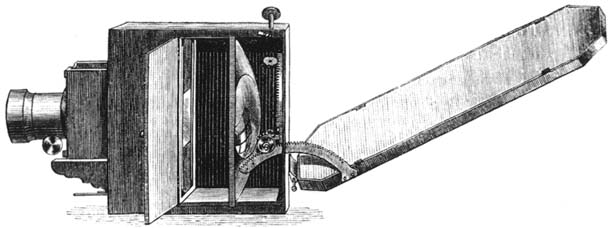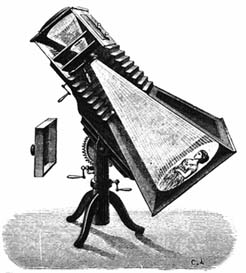Solar Camera precursors of film and movie
Solar cameras are the first widely known cameras in history. The camera was the first serious step towards the emergence of cinema. Therefore, in this article I will talk about them in more detail.
.
A solar camera, also known as a pinhole camera, works on the principle of the camera obscura. The camera obscura is a device that projects an inverted image of the outside world onto a surface inside the camera through a small aperture, known as the pinhole.
The camera consists of a light-tight box or chamber with a small hole (the pinhole) on one side. Light enters the box through the pinhole and creates an inverted image of the scene on the opposite side of the box. This image can be captured on a piece of film or a digital sensor placed on the opposite side of the pinhole.
The size of the pinhole and the distance between the pinhole and the film or sensor determine the sharpness and brightness of the final image. A smaller pinhole will result in a sharper image, but less light will enter the camera, making the image darker. A larger pinhole will allow more light to enter, resulting in a brighter image, but the image will be less sharp.
The use of a pinhole instead of a lens allows a solar camera to capture an image without the need for expensive optics, making it an inexpensive and simple way to capture photographs.
The evolution of the solar camera.
Solar microscope: The solar microscope, invented by Thomas Wedgwood and Humphry Davy in 1740, was an early version of the pinhole camera. It used a small aperture to project an inverted image of the sun onto a piece of paper or a screen, allowing for the observation of solar phenomena such as sunspots.
David Acheson Woodward's 1857: David Acheson Woodward made improvements to the solar microscope by using a mirror to reflect sunlight into the pinhole and onto the paper or screen. This allowed for a brighter and more detailed image of the sun.
Antoine Claudet 1862: Antoine Claudet presented "On the means of following the small divisions of the scale regulating the distances and enlargement in the solar camera" in 1862. He also exhibited a number of life-size portrait enlargements from carte de visite negatives. He made advances in the field of photography by creating a solar camera that could capture detailed, life-size images.
Jacob Wothly of Aachen: Jacob Wothly of Aachen improved upon Woodward's design by adding a reflector and condenser, as well as a clockwork heliostat, which was similar to the one invented by Léon Foucault in 1862. This allowed for the capture of even brighter and more detailed images.
Désiré van Monckhoven: In August 1863, Désiré van Monckhoven registered a patent for "an optical apparatus intended for enlarging by projection." This invention allowed for the projection of enlarged images, making it possible to view large-scale photographs in a group setting.
Gaspard-Félix Tournachon: Gaspard-Félix Tournachon made further improvements to the solar camera by inventing a hand-operated drive. This made it possible to move the camera and capture images of moving subjects, such as people and animals.
Why the solar camera failed.
The solar camera, also known as the pinhole camera, ultimately failed to become a widely adopted technology for several reasons. One of the main reasons was the limitations of the technology itself. Pinhole cameras required long exposure times, which made it difficult to capture moving subjects and resulted in blurry images. Additionally, the small size of the pinhole resulted in a limited amount of light entering the camera, resulting in darker, less detailed images.
Another reason for the failure of the pinhole camera was the invention of the lens-based camera. The lens-based camera was able to capture sharper, clearer images with shorter exposure times. This made it a more practical and versatile option for photographers and artists.
Furthermore, the pinhole camera was not widely adopted by the commercial photography industry, as it was considered to be a more artistic and experimental medium. The lens-based camera was more suitable for commercial photography due to its ability to capture high-quality images quickly and easily.
Finally, pinhole cameras were also more difficult to use, requiring a great deal of skill and knowledge to operate. This limited the number of people who could successfully use the technology.
All in all, while the pinhole camera was an important invention that laid the foundation for the development of modern photography, its limitations and the advancements in lens-based camera technology ultimately led to its failure to become a widely adopted technology.






Comments
Post a Comment